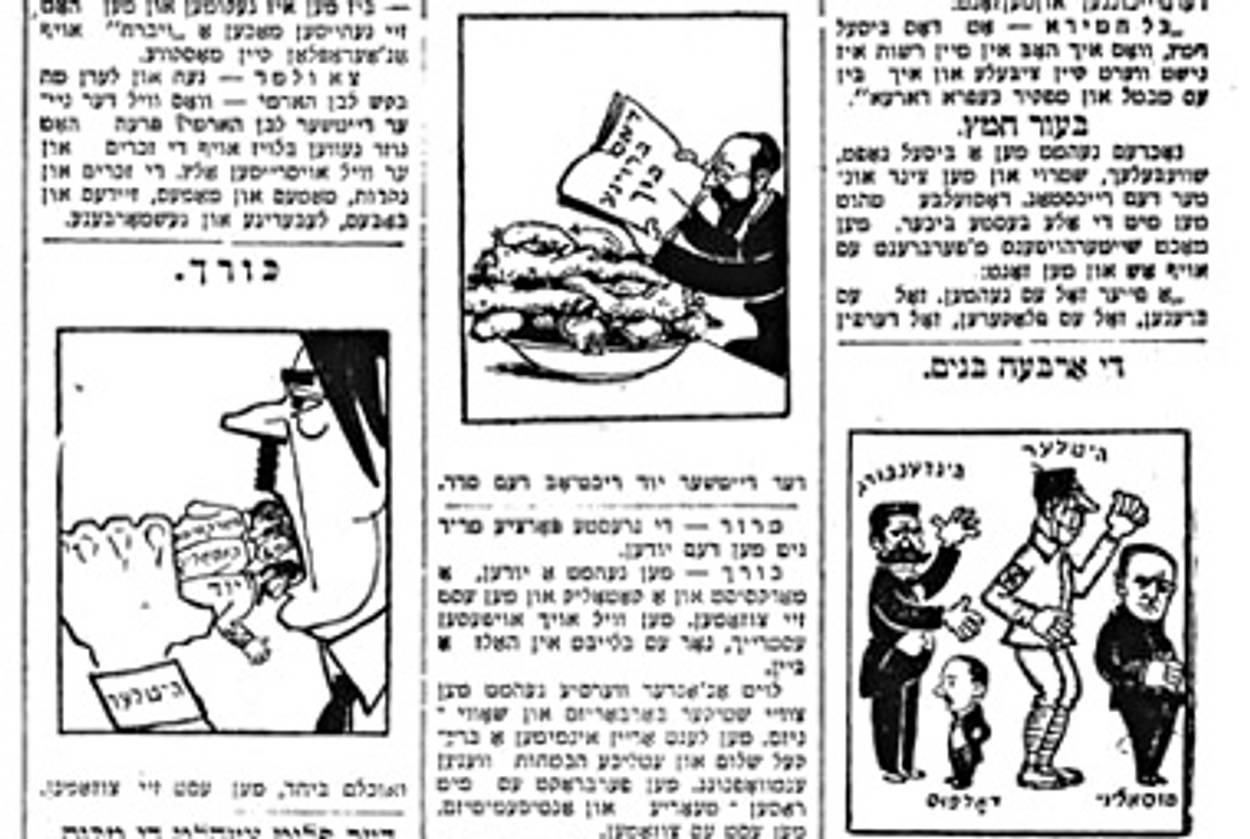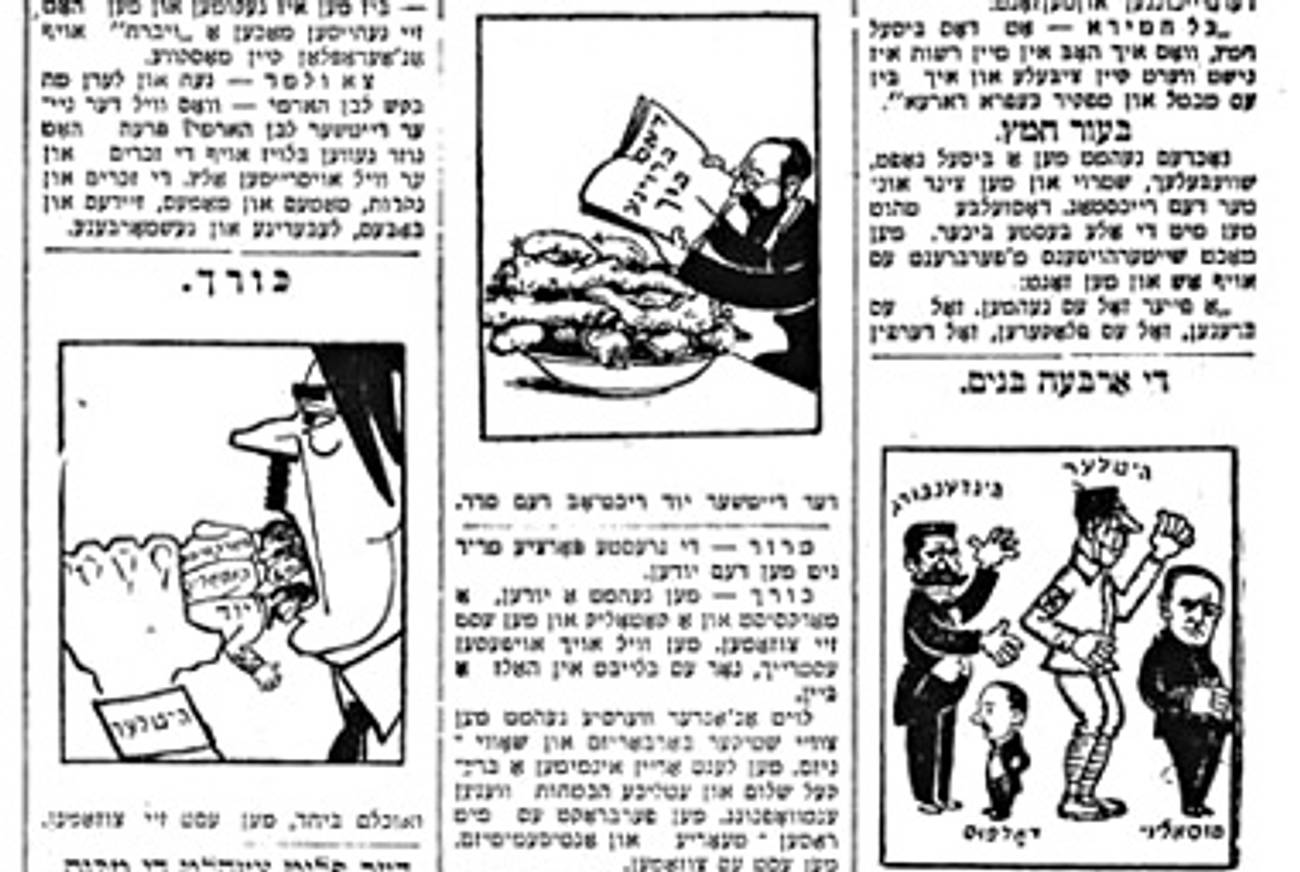Paschal Lampoon
Forget Purim. Passover has a rich comedic tradition all its own, with parodies of the haggadah mocking everything from rabbis and the rich to Mussolini and Hitler.




Rarely do people hear the word “Passover” and think “hilarious.” But as early as the 13th century, there emerged a Jewish comedic tradition of creating parodies of the haggadah. By the 19th century, the Jewish Enlightenment’s penchant for parody created a robust mock haggadah industry, with imitations of the Seder liturgy burlesquing nearly every aspect of Jewish life.
Appearing every spring in the Yiddish press and in humor journals produced specifically for Passover, these haggadot lampooned the poor, the rich, communists, socialists, capitalists, alcoholics, farmers, lepers, immigrants, loose women, politicians, rabbis, Hebrew teachers, even vacation homes. You name it and there is probably a mock haggadah skewering it.
Some of these spoofs functioned as political propaganda or critical commentary masked as holiday fare. Leftist ideologues, often products of the yeshiva world, took to undermining the traditional texts they knew so well. An early, beloved secular parody first appeared in the London-based Worker’s Friend in 1887 and was reprinted multiple times as the Socialist Haggadah. Lamenting the pitiful situation of the Jewish worker versus the exploitative Jewish capitalist, the author took a text familiar to every Jew and used it to promote socialism:
“Ma nishtane, why are we different from Shmuel the manufacturer, from Meyer the banker, from Zorach the money lender, from Reb Todros the rabbi? They don’t do anything and they have food and drink during the day and also at night at least a hundred times over, we toil with all our strength the whole day and at night we have nothing to eat at all.”
But every parodist had an ax to grind, and if the subject being parodied wasn’t the might of the capitalist bourgeoisie, it was something else. In 1909, a New York satirical weekly, Der groyser kundes, worked a bit of Yiddish-theater criticism into its haggadah:
“Ma nishtane, why is the current theater season worse this year than in all previous seasons? Shebekhol halaylos, every season for the past ten years had chometz and matzah, awful potboilers, but also some good literary dramas, and this season has been only unadulterated crap.”
The characterizations of the four sons in a 1916 Der groyser kundes parody might seem dated in the details, but its underlying dynamics are surprisingly familiar:
“The Wise Son: a shtetl horse thief who escaped from prison, stowed-away on a ship to America where he became a horse poisoner and a gangster until he managed to become a saloon keeper and a politician. Today he’s the president of his synagogue, a fighter for Judaism, in short, a mentsh …
“The Wicked Son: a man who fills his wallet with relief receipts for victims of the war that he picked up off the ground and shows them to volunteers asking for money to prove what a big philanthropist he is. ‘See how much I already gave?’
“The Simple Son: a kid who sits with a girl until 2 a.m. waiting for permission to kiss her.
“The Son Who Doesn’t Even Know How to Ask a Question: a traveling salesman who only comes home on Passover to find his wife about to give birth and doesn’t think to ask how a woman can be pregnant for 12 months.”
By the early 20th century, the haggadah had become the most parodied text in Jewish history. It’s easy to see why: With its fixed structure of four questions, four brothers, and 10 plagues, it is a simple text to manipulate. The vast majority of Jews—from children to the elderly—were at least nominally familiar with the text, a fact that made the gags easy to understand.
The parodies ranged in scope and ambition, from a 1911 advertisement titled “The Eleventh Plague,” which explained how the most horrible affliction of the Passover holiday was hemorrhoids, to longer parodies that took the “Kadesh, Urkhats” Seder mnemonic and played on the various duties required of Seder participants. Some parodies are complete haggadahs unto themselves.
The quality of the parodies often depended on the Yiddish news cycle. Local and international news always crept into these works. A good local scandal often made for the juiciest parody. When, for example, a political scandal surrounding a Jewish beauty pageant in Warsaw exploded in the early spring of 1929, Yiddish satirists produced an unusual amount of beauty pageant-related Passover material.
But politics was always paramount in the Yiddish press, and the roles of the four sons and the 10 plagues were often filled with political figures. The Hitler Haggadah of 1934 is a typical example.
Appearing in the humor section of the Warsaw daily Moment, just prior to Passover, the Hitler Haggadah zips through the main sections of the text with all manner of sarcastic political commentary in Yiddish interspersed with the original Hebrew. The four sons are Mussolini (wise), Hitler (wicked), Austrian Prime Minister Engelbert Dollfuss (simple), and Paul von Hindenburg (doesn’t know to ask a question). The 10 plagues are transformed into the litany of problems facing German Jewry. The parody is a pastiche of bitterness: A cartoon shows a German Jew sitting in front of a huge bitter pile of horseradish. The four questions wonder how long the Nazis will stay in power. Hitler, who ostensibly answers but simply dodges the questions, is compared to Laban the Aramean, a figure considered to be the Deus ex machina of the Exodus by some rabbis. But Pharaoh only killed the first-born males, whereas Hitler “wants to uproot everything: the males, the females, fathers and mothers, grandfathers and grandmothers, the living and even the dead,” a frightening premonition of what was to come.
Eddy Portnoy, a contributing editor for Tablet Magazine, is the Academic Advisor and Exhibitions Curator at the YIVO Institute for Jewish Research. He is also the author of Bad Rabbi and Other Strange but True Stories from the Yiddish Press.
Eddy Portnoy is academic adviser and director of exhibitions at the YIVO Institute for Jewish Research, as well as the author of Bad Rabbi and Other Strange but True Stories from the Yiddish Press (Stanford University Press 2017).